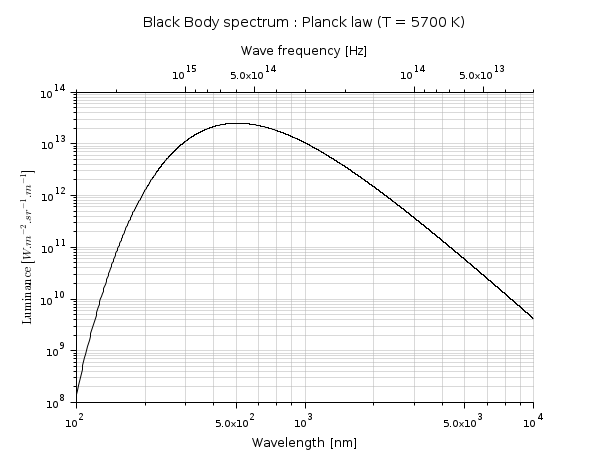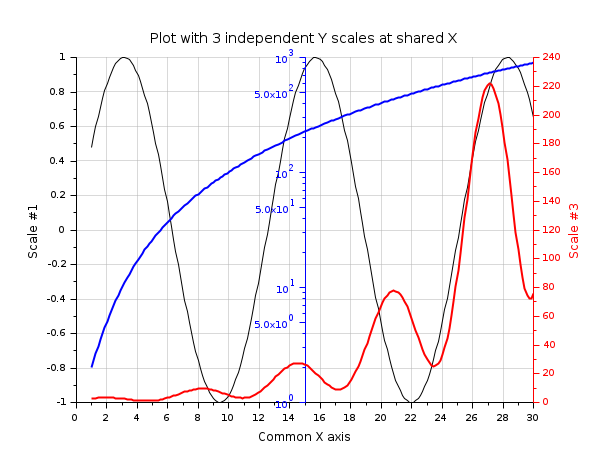multiscaled plots
How to set several axes for one curve or for curves with distinct scales
Description
Several situations may need to use and set several cartesian X axes or several cartesian Y axes, as for instance:
- We want to read the same curve according to distinct scales along
multiple X or Y axes:
If the relationship between both scales is affine (such as y'=a.y+b) and linear axes must be rendered, drawaxis() can be used.
If the relationship between both scales is a power law (such as y'=a.y^b), using logarithmic axes and newaxes() will be required.
gca().tight_limitsproperty will have to be set to "on" in the considered direction We want to overplot several curves sharing the same X abscissae but according to distinct uncorrelated Y scales. Then, one or several overlaying axes will be set using newaxes().
Examples
Water density: Two X linear scales for the same curve
t = linspace(0,10,100); tf = t*1.8+32; d = -6.863e-3*t.^2 + 0.05463*t + 999.84; clf // Main plot plot(t,d) xgrid(color("grey70")*[1 1],[1 1], [7 7]) title("Water density","fontsize",3) xlabel("Temperature [°C]") ylabel("$kg.m^{-3}$", "fontsize",3) // Making some space for the 2nd X-label ax = gca(); ax.margins(3) = 0.2; ax.title.position(2) = 1000.0; // Drawing the 2nd temperature axis in °F, + labelling it: xf = 32:50; atf = drawaxis(dir='u', tics="v", x=(xf-32)/1.8, y=999.96, val=msprintf("%d\n",xf') ) c = color("magenta"); set(atf, "tics_color",c, "labels_font_color",c) xstring(5,999.99,"Temperature [°F]") set(gce(), "clip_state", "off", "text_box_mode", "centered","font_foreground",c); gcf().axes_size = [610 510];

Light spectrum, versus both wavelengths and frequencies: two correlated logarithmic X scales.
function r=Planck(T, lambda) h = 6.626e-34; // Planck constant [J.s] c = 298792458; // light speed [m/s] k = 1.381e-23; // Boltzmann constant [J/K] // stef = 5.670374e-8 // Stefan constant [W/m2/K4] r = 2*h*c^2 ./ lambda.^5 ./ (exp(h*c./(lambda*k*T))-1); endfunction clf lambda = (100:10000); plot2d("ll", lambda, Planck(5700, lambda*1e-9)*1e-6) xlabel("Wavelength [nm]", "fontsize",2) ylabel("$\text{Luminance }[W.m^{-2}.sr^{-1}.µm^{-1}]$", "fontsize", 2) xgrid(color("grey70")*[1 1],[1 1],[7 7]) a1 = gca(); a1.margins(3) = 0.20; a1.sub_tics(2) = 8; // 2nd axes, superimposed to the first one a2 = newaxes(); a2.data_bounds = [3e13,0;3e15 ,1]; a2.Axes_reverse(1) = "on"; a2.axes_visible(1) = "on"; set(a2, "filled", "off", "log_flags","lnn", "x_location","top") a2.tight_limits(1) = "on"; a2.margins(3) = 0.20; xlabel("Wave frequency [Hz]", "fontsize",2) title("Black Body spectrum : Planck law (T = 5700 K)", "fontsize",3)

pH: A single curve, with two correlated Y scales: one linear, one logarithmic.
pH1 = 1.5; // v1 = 10 mL of acid solution pH2 = 12.5; // v2 mL of basic solution v2 = logspace(0,4,200); // naive raw pH estimation after mixing pH = -log10((10*(10.^-pH1) + v2*(10.^-pH2))./(10+v2)); clf plot2d("ln",v2, pH) ax1 = gca(); ax1.tight_limits(2) = "on"; ax1.sub_ticks(1) = 8; xgrid(color("grey70")*[1 1],[1 1],[7 7]) title("Acidity after mixing V mL of pH=13.5 to 10 mL of pH=1.5", "fontsize",3) xlabel("V (mL)", "fontsize",3) ylabel("pH", "fontsize",3); // [H^+] logarithmic 2nd scale ax2 = newaxes(); ax2.data_bounds([4 3]) = 10.^(-ax1.data_bounds([3 4])); set(ax2, "filled","off", "y_location","right", "log_flags","nln") ax2.tight_limits(2) = "on"; ax2.axes_visible(2) = "on"; ax2.axes_reverse(2) = "on"; ylabel("$[H^+]\text{ concentration }(mol.L^{-1})$","fontsize",3) ax2.y_label.font_angle = 90;

Three overplotted curves sharing the same X axis, with 3 independent Y scales:
// Preparing data x = linspace(1,30,200); y2 = exp(x/6).*(sin(x)+1.5); y3 = 1+x.^2; clf // Black curve => y1 scale (left axis) y1 = sin(x/2); plot2d(x, y1) title(_("Plot with 3 independent Y scales at shared X"), "fontsize",3); xlabel(_("Common X axis"), "fontsize",2); ylabel(_("Scale #1"), "fontsize",2); xgrid(color("grey70")*[1 1], [1 1], [7 7]) // Blue curve => y2 scale (middle axis) c = color("blue"); ax2 = newaxes(); set(ax2, "filled", "off", "foreground", c, "font_color", c); plot2d(x, y3, logflag="nl", style=c) gce().children.thickness = 2; ax2.axes_visible(1) = "off"; ax2.y_location = "middle"; // Red curve => y3 scale (right axis) c = color("red"); ax3 = newaxes(); set(ax3, "filled", "off", "foreground", c, "font_color", c); plot2d(x,y2,style=c); ylabel(_("Scale #3"),"color",[1 0 0]) gce().children.thickness = 2; ax3.axes_visible(1) = "off"; ax3.y_location = "right";

| Report an issue | ||
| << pie | Graphics | xchange >> |